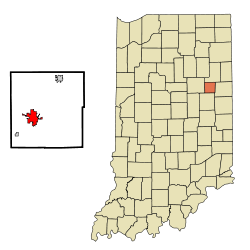Hartford City, Indiana
| Hartford City, Indiana | |
|---|---|
| City | |
| Motto: "The One And Only" | |
 Location in the state of Indiana |
|
| Coordinates: 40°27′09″N 85°22′10″W / 40.45250°N 85.36944°WCoordinates: 40°27′09″N 85°22′10″W / 40.45250°N 85.36944°W | |
| Country | United States |
| State | Indiana |
| County | Blackford |
| Officially named | 1839 |
| Incorporated (town) | 1857 |
| Incorporated (city) | 1894 |
| Government | |
| • Mayor | Ben Hodgin (D) |
| Area | |
| • Total | 3.90 sq mi (10.10 km2) |
| • Land | 3.88 sq mi (10.05 km2) |
| • Water | 0.02 sq mi (0.05 km2) |
| Elevation | 919 ft (280 m) |
| Population (2010) | |
| • Total | 6,220 |
| • Estimate (2012) | 6,091 |
| • Density | 1,603.1/sq mi (619.0/km2) |
| Time zone | EST (UTC-5) |
| • Summer (DST) | EDT (UTC-4) |
| ZIP code | 47348 |
| Area code(s) | 765 |
| FIPS code | 18-32242 |
| GNIS feature ID | 0435826 |
| Website | http://www.hartfordcity.net |
Hartford City is a city in the U.S. state of Indiana, and the county seat of Blackford County. Located in the northeast central portion of the state, the small farming community experienced a 15-year “boom” beginning in the late 1880s. The Indiana Gas Boom was caused by the discovery of natural gas in the area, and it caused the community to transition from an agricultural economy to one that also included manufacturing. The boom brought residents, retail establishments, and craftspeople. The increased population meant construction of new roads, schools, and churches. After the boom came a long period of growth and stability. Agriculture (and agricultural trade) remained as the fundamental industry.
From the 1920s through the 1970s, Hartford City continued to thrive. Agricultural automation and consolidation of small farms into industrial-size farms started a decline in the population as the small farmer became unable to compete and fewer people were required as laborers. Some workers turned to the manufacturing and construction sectors for employment in nearby cities. However, manufacturing hubs like Muncie and Marion saw the collapse of their economies when large factories closed. Despite the decline, Hartford City was able to retain its paper company, 3M. The city government has concentrated on bringing manufacturing to Hartford City and has had some success on securing state funding for businesses that use recycled materials or agricultural materials in the manufacturing process. Younger people leave to attend college and pursue professional careers outside the scope of those available in Hartford City. Community college, private colleges, and a university are within commuting distance; however, Hartford City currently lacks rental housing appropriate to college students or young adults. The town’s population was 6,220 at the 2010 United States Census. The city is located within Licking Township in the southwest portion of the county.
Hartford City, Indiana began in the late 1830s as a few log cabins clustered near a creek. Folklore taught in local elementary schools suggested that Hartford City was originally a place to cross Lick Creek, known as “Hart’s ford.” This evolved to Hartford, and was eventually changed to Hartford City to avoid confusion with another Hartford located within the state. The community became the county seat of Blackford County. During the last half of the 19th Century, East Central Indiana consisted mostly of rural farming communities, including Hartford City. The town's population did not exceed 2,000 until after 1887, when the region began to grow because of the Indiana Gas Boom.
...
Wikipedia
